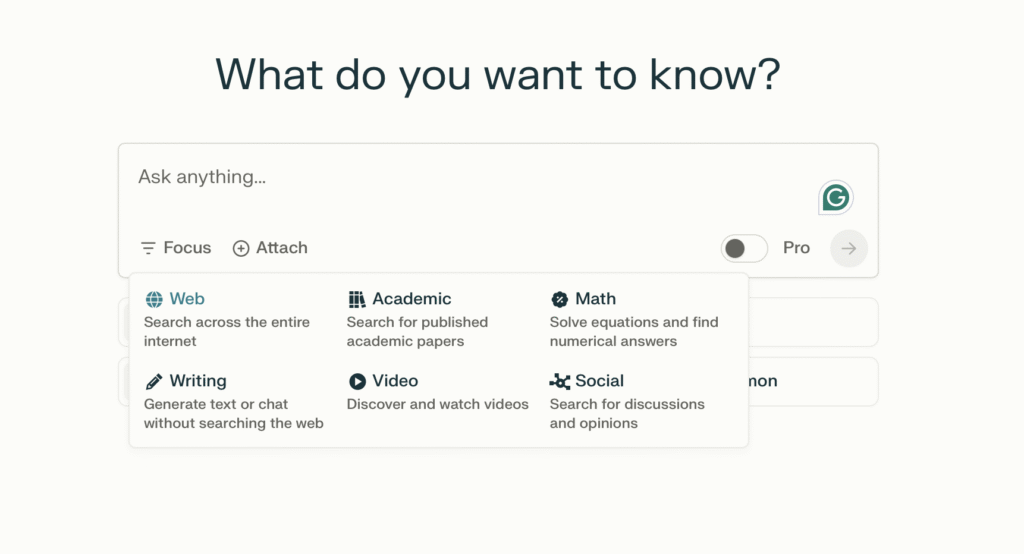If you’ve ever asked yourself “what are the different focus modes available in perplexity ai?” you’re not alone. A lot of daily users wonder why there are so many little toggles in the search bar and what they actually do.
The short answer: Focus Modes are like filters for your questions. They shape how Perplexity pulls results and the kind of answers you get back. For anyone using Perplexity every day whether that’s for study, work, or just curiosity knowing when to switch modes can make your searches faster and far more useful.
Table of Contents
Why perplexity Focus Modes matter
Imagine you walk into a huge library. You could wander the aisles and grab the first book you see, or you could head straight to the section that fits your topic. That’s exactly what Focus Modes do inside Perplexity.
Instead of always searching the entire web, you can tell it: “Look at research papers only.” Or “Pull from videos so I don’t have to watch hours of content.”
For anyone just starting out with AI tools, this might sound a bit magical. But it’s grounded in simple logic. If you want to understand the basics first, I’d recommend my earlier post <What is AI> it gives you the foundation before diving into these advanced features.
A Quick Look at the perplexity Modes
Here’s the menu you’ll see when you open Focus:
- Web (default)
- Academic
- Video
- Social
- Writing
- Math
- Pro search
- Labs

Each one has its sweet spot, and knowing when to pick the right one is the real trick.
Web Focus
This is the standard mode, and for most casual searches, it’s all you need.
- Good for: General knowledge, trending news, fact-checking.
- Pulls from: Websites, blogs, news articles.
- Skip it when: You want solid citations or technical depth.
Prompts to try:
- “Compare the Mediterranean diet vs the DASH diet in plain English.”
- “Give me the latest updates on electric cars in 2025.”
Academic Focus
This is where Perplexity earns respect among students, researchers, and professionals. It skips the fluff and pulls straight from peer-reviewed journals and scholarly articles.
- Good for: Essays, reports, citing real studies.
- Pulls from: Research databases, journals, academic sources.
- Skip it when: You just need a simple definition or casual overview.
Prompts to try:
- “Summarize recent studies on renewable energy adoption in Asia.”
- “Explain how microplastics affect human health, with sources.”
And if you’re using this for serious work, be careful not to take everything at face value. I talk about this in <How to cautiously use AI for work> worth a read if you rely on these tools for important projects.
Video Focus
Ever wished you could watch a 45 minute lecture in two minutes? That’s exactly what this mode is for.
- Good for: YouTube lectures, tutorials, podcasts, conference talks.
- Pulls from: Transcripts, timestamps, video metadata.
- Skip it when: The topic has little video coverage.
Prompts to try:
- “Summarize the TED Talk about climate resilience with key timestamps.”
- “Break down the main points in the YouTube video ‘Quantum Computing Explained Simply.’”
Social Focus
Sometimes the best insights come from people, not articles. Social Focus digs into Reddit, forums, and communities to surface what real users are saying.
- Good for: Product reviews, sentiment analysis, trending topics.
- Pulls from: Reddit, forums, community spaces.
- Skip it when: You need reliable facts or formal references.
Prompts to try:
- “What are Reddit users saying about the new iPhone 17 battery?”
- “Summarize the top discussions about remote work productivity.”
Writing Focus
This mode flips from searching to creating. It’s perfect for drafting, outlining, or even coding. If you’re someone who writes a lot, this is the mode that saves you hours.
- Good for: Blog outlines, emails, code snippets, brainstorming ideas.
- Pulls from: A mix of sources + generative help.
- Skip it when: You only need verified data.
Prompts to try:
- “Draft an outline for a blog on the benefits of daily walking.”
- “Write a simple Python script to fetch today’s weather data.”
One thing to keep in mind here: text from Writing Focus can sometimes sound too polished or robotic. I dug into this in <Why is my writing getting flagged as AI> a useful read if you want to keep your style natural.
Math Focus
Math Mode is a lifesaver for number-heavy tasks. Instead of Googling formulas, you get step-by-step answers powered by Wolfram Alpha.
- Good for: Equations, conversions, data analysis.
- Pulls from: Wolfram Alpha and structured computational sources.
- Skip it when: You’re asking open-ended or creative questions.
Prompts to try:
- “Solve 3x² + 5x – 7 = 0 step by step.”
- “List prime numbers up to 500.”
- “Convert 200 kilometers per hour to miles per hour.”
Pro Search
This is the deep-thinking mode inside Perplexity. Instead of skimming the surface, it reasons step by step, pulls from stronger models, and gives you well-rounded answers with clear citations.
- Good for: Complex questions, technical explanations, code debugging, or multi-step reasoning that needs more than a quick reply.
- Pulls from: Advanced models like GPT-4.1, Claude 4 Sonnet, Gemini 2.5 Pro (depending on plan). It combines these with high-quality sources for detailed, cited answers.
- Skip it when: You just need a fast, simple answer—basic search is quicker for that.
Prompts to try:
- “Break down the pros and cons of solar vs nuclear energy in detail.”
- “Debug this Python code and explain the error step by step.”
Labs
This is Perplexity’s creative mode. Instead of just answers, it builds assets tables, graphs, mini-documents, even small apps.
- Good for: Research projects, reports, interactive data, creative experiments.
- Pulls from: AI’s ability to generate structured assets, not just text.
- Skip it when: You need fast answers. Labs can take several minutes.
Prompts to try:
- “Build me a comparison table of major smartphone releases in 2025.”
- “Create a simple budget planner with categories and formulas.”
| Mode | Function | Use Case | Audience |
| Web Search | General web search | Quick queries, facts | General users |
| Pro Search | Deep, comprehensive research | Complex questions, reports | Students, professionals |
| Writing | Text generation, code | Creative, technical tasks | Writers, developers |
| Academic | Scholarly research | Peer-reviewed articles | Researchers, students |
| Video | Summarize video content | Video key points | Content creators |
| Labs | Builds projects, apps | Project work, dashboards | Advanced users |
| Math | Solve math problems | Complex equations | Students, educators |
Switching Between Modes
On desktop, you’ll see the Focus menu right next to the search bar. On mobile, it’s under the dropdown.
If you’re on an Enterprise Pro plan, Focus looks a bit different. Instead of the six modes, you’ll see Choose sources where you can pick between Web, internal files, both, or none. Same idea, just designed for workplace use.
Smart Workflows for Daily Use
Here’s where Focus really shines: combining modes.
- Research smarter: Start with Academic to find papers → check Web for news context → finish in Writing to draft your own summary.
- Learn faster: Use Video to summarize a lecture → cross-check with Academic for reliability.
- Fact + opinion: Web for verified details → Social to see how real people react.
These combos are where Perplexity becomes more than just a Q&A tool. It starts feeling like a true research assistant.
Common Issues and Quick Fixes
- Focus not showing up? You might be on Enterprise where it’s replaced with Choose sources.
- PDF limits? Break files into smaller uploads.
- Slow or missing results? Switch modes or re-run the query.
Most problems have simple workarounds, and honestly, learning when to pivot modes is part of the daily flow.
Wrapping Up
So what are the different focus modes available in perplexity ai? Now you know: Web, Academic, Video, Social, Writing, Math, Pro, and labs Each one has its own strengths, and the real magic comes when you start combining them.
If you’re a daily user, don’t just stick to default Web searches. Play around. Use Academic for research, Video to cut down hours of watching, Social to tap into community chatter, Writing when you need to create, and Math when numbers come into play.
That’s how you unlock the full value of Perplexity.
Can I run two Focus Modes at once?
Not directly, but you can run searches back-to-back and blend the results.
Why don’t I see Focus on my account?
Enterprise accounts use Choose sources instead.
Is Math Mode really Wolfram Alpha?
Yes behind the scenes, it’s powered by Wolfram.
Is Video Focus accurate for all YouTube content?
Only when transcripts are available.
Which Focus Mode should I use daily?
Web is the go-to, but switching depending on your task saves a lot of time.







Leave a Comment